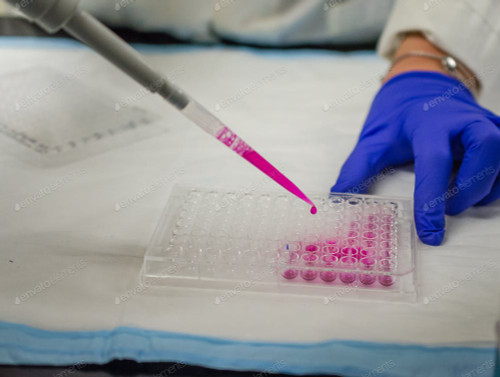Product Description
Recombinant Mouse Dual specificity mitogen-activated protein kinase kinase 4 (Map2k4) is available at Gentaur for Next week Delivery.
Gene Name: Map2k4
Alternative Names : C-JUN N-terminal kinase kinase 1;JNK kinase 1;JNKK 1JNK-activating kinase 1MAPK/ERK kinase 4;MEK 4SAPK/ERK kinase 1;SEK1
Expression Region : 2-397a
AA Sequence : AAPSPSGGGGSGGGGGTPGPIGPPASGHPAVSSMQGKRKALKLNFANPPVKSTARFTLNPNTTGVQNPHIERLRTHSIESSGKLKISPEQHWDFTAEDLKDLGEIGRGAYGSVNKMVHKPSGQIMAVKRIRSTVDEKEQKQLLMDLDVVMRSSDCPYIVQFYGALFREGDCWICMELMSTSFDKFYKYVYSVLDDVIPEEILGKITLATVKALNHLKENLKIIHRDIKPSNILLDRSGNIKLCDFGISGQLVDSIAKTRDAGCRPYMAPERIDPSASRQGYDVRSDVWSLGITLYELATGRFPYPKWNSVFDQLTQVVKGDPPQLSNSEEREFSPSFINFVNLCLTKDESKRPKYKELLKHPFILMYEERTVEVACYVCKILDQMPATPSSPMYVD
Sequence Info : Full Length of Mature Protein
Tag Info : N-terminal 6xHis-SUMO-tagged
Theoretical MW : 60 kDa
Storage Buffer : Tris/PBS-based buffer, 5%-50% glycerol. If the delivery form is lyophilized powder, the buffer before lyophilization is Tris/PBS-based buffer, 6% Trehalose, pH 8.0.
Endotoxin Level : Not tested-
Biological Activity : Not tested
Storage : Short term: -20°C; Long term: -80°C. Minimize freeze and thaw cycles.
Research Area : Others
Restriction : For Research Use Only. Not for use in diagnostic procedures, drug use, or for administration to humans or animals.
Relevance : Dual specificity protein kinase which acts as an essential component of the MAP kinase signal transduction pathway. Essential component of the stress-activated protein kinase/c-Jun N-terminal kinase (SAP/JNK) signaling pathway. With MAP2K7/MKK7, is the one of the only known kinase to directly activate the stress-activated protein kinase/c-Jun N-terminal kinases MAPK8/JNK1, MAPK9/JNK2 and MAPK10/JNK3. MAP2K4/MKK4 and MAP2K7/MKK7 both activate the JNKs by phosphorylation, but they differ in their preference for the phosphorylation site in the Thr-Pro-Tyr motif. MAP2K4 shows preference for phosphorylation of the Tyr residue and MAP2K7/MKK7 for the Thr residue. The phosphorylation of the Thr residue by MAP2K7/MKK7 ses to be the prerequisite for JNK activation at least in response to proinflammatory cytokines, while other stimuli activate both MAP2K4/MKK4 and MAP2K7/MKK7 which synergistically phosphorylate JNKs. MAP2K4 is required for maintaining peripheral lymphoid homeostasis. The MKK/JNK signaling pathway is also involved in mitochondrial death signaling pathway, including the release cytochrome c, leading to apoptosis. Whereas MAP2K7/MKK7 exclusively activates JNKs, MAP2K4/MKK4 additionally activates the p38 MAPKs MAPK11, MAPK12, MAPK13 and MAPK14.
Function : Dual specificity protein kinase which acts as an essential component of the MAP kinase signal transduction pathway. Essential component of the stress-activated protein kinase/c-Jun N-terminal kinase (SAP/JNK) signaling pathway. With MAP2K7/MKK7, is the one of the only known kinase to directly activate the stress-activated protein kinase/c-Jun N-terminal kinases MAPK8/JNK1, MAPK9/JNK2 and MAPK10/JNK3. MAP2K4/MKK4 and MAP2K7/MKK7 both activate the JNKs by phosphorylation, but they differ in their preference for the phosphorylation site in the Thr-Pro-Tyr motif. MAP2K4 shows preference for phosphorylation of the Tyr residue and MAP2K7/MKK7 for the Thr residue. The phosphorylation of the Thr residue by MAP2K7/MKK7 seems to be the prerequisite for JNK activation at least in response to proinflammatory cytokines, while other stimuli activate both MAP2K4/MKK4 and MAP2K7/MKK7 which synergistically phosphorylate JNKs. MAP2K4 is required for maintaining peripheral lymphoid homeostasis. The MKK/JNK signaling pathway is also involved in mitochondrial death signaling pathway, including the release cytochrome c, leading to apoptosis. Whereas MAP2K7/MKK7 exclusively activates JNKs, MAP2K4/MKK4 additionally activates the p38 MAPKs MAPK11, MAPK12, MAPK13 and MAPK14.
Involvement in disease :
Subcellular location : Cytoplasm, Nucleus
Protein Families : Protein kinase superfamily, STE Ser/Thr protein kinase family, MAP kinase kinase subfamily
Tissue Specificity : Strong expression is detected in most of the central nervous system and in liver and thymus during early stages of development. While expression in nervous system increases over time, expression in fetal liver and thymus gradually decreases as embryogenesis proceeds. High level of expression in the central nervous system persists throughout postnatal development and remained at a stable level in adult brain.
Paythway :
Uniprot ID : P47809
 Euro
Euro
 British Pound
British Pound
 US Dollar
US Dollar








